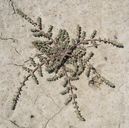Taxon Report
Atriplex depressa Jeps.brittlescale |
 © 2009 Zoya Akulova |
Taxon Summary
Atriplex depressa, commonly known as brittlescale, is a annual herb in the Chenopodiaceae that is found only in California. It occurs within Chenopod scrub, Meadows and seeps, Playas, Valley and foothill grassland, and Vernal pools, growing at elevations from 1 to 320 meters. Atriplex depressa is ranked 1B.2, Plants Rare, Threatened or Endangered in California and Elsewhere; Moderately threatened in California.Classification
|
Scientific Name: |
Atriplex depressa Jeps. |
|
Common Name: |
brittlescale |
| Family: | Chenopodiaceae |
| Element Code: | PDCHE042L0 |
| USDA Plants Symbol: | ATDE3 |
|
Synonyms/Other Names: |
|
Ecology and Life History
| Lifeform: | annual herb |
| Blooming Period: Apr-Oct | Apr-Oct |
| Elevation: | 1-320 (5-1050) |
| General Habitats: | Chenopod scrub, Meadows and seeps, Playas, Valley and foothill grassland, Vernal pools |
| Microhabitat: | Alkaline, Clay |
| Microhabitat Details: |
Conservation Status
| CA Rare Plant Rank: | 1B.2 |
| Global Rank: | G2 |
|
State Rank: |
S2 |
| State List: | None |
| Fed List: | None |
| Other Status: | |
|
CRPR Changes: |
|
Occurrence Data from the CNDDB
| Total Occurrences: | 60 |
| Element Occurrence Ranks: | |
| Excellent (A) | 5 |
| Good (B) | 18 |
| Fair (C) | 5 |
| Poor (D) | 1 |
| None (X) | 1 |
| Unknown (U) | 30 |
| California Endemic: True | |
| California Counties and Islands: Name (Code) | |
| Alameda (ALA), Colusa (COL), Contra Costa (CCA), Fresno (FRE), Glenn (GLE), Kings (KNG), Merced (MER), Solano (SOL), Tulare (TUL), Yolo (YOL) | |
| Quads: Name (Quad Code) | |
| Allensworth (3511974), Altamont (3712166), Antioch South (3712187), Arbuckle (3912211), Byron Hot Springs (3712176), Colusa (3912221), Davis (3812156), Denverton (3812128), Dozier (3812137), Elmira (3812138), Grays Bend (3812166), Guijarral Hills (3612022), Helm (3612051), Jamesan (3612062), Laton (3611946)*, Livermore (3712167), Logandale (3912242), Manor Slough (3912223), Milpitas (3712148), Monson (3611943), Moulton Weir (3912231), Sausalito School (3511982), Sites (3912233), Stevinson (3712037), Stonyford (3912245), Tranquillity (3612063), Traver (3611944)*, Visalia (3611933), Willows (3912252)* | |
Threat List Data from the CNDDB
| Threat List Total: | 12 | |
| EOs with Threat Listed: | Total EOs | % of EOs |
| 24 | 40 % | |
| Grazing | 11 | 18% |
| Development | 9 | 15% |
| Agriculture | 8 | 13% |
| Non-native plant impacts | 6 | 10% |
| Disking | 2 | 3% |
| Foot traffic/trampling | 2 | 3% |
| Mining | 1 | 1% |
| Altered flood/tidal/hydrologic regime | 1 | 1% |
| Biocides | 1 | 1% |
| Dam/Inundation | 1 | 1% |
| Other | 1 | 1% |
| Recreational use (non-ORV) | 1 | 1% |
Citation
California Native Plant Society, Rare Plant Program. 2025. Rare Plant Inventory (online edition, v9.5.1). Website https://www.rareplants.cnps.org [accessed 5 December 2025].